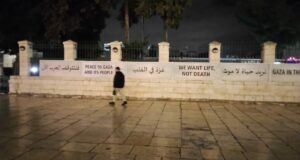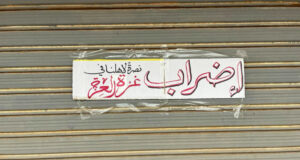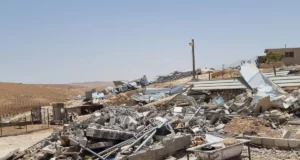26 September 2010 | ISM Media
Brutal suppression of the Palestinian popular struggle continues: A Palestinian man was shot in the leg with live ammunition in Bil`in, while live rounds were also fired in Ni`lin and An-Nabi Saleh, where rubber-coated steel bullets were fired at children. In Beit Ummar a Palestinian man was beaten unconscious by Israeli forces yet only an innocent French peace activist was arrested for assault. Demonstrators marched around the Old City in Hebron, and burned settlement goods in Al-Ma`sara, showing their support and solidarity to the people of Silwan where a Palestinian man was killed by a private settler guard on Wednesday.
Friday demonstrations

Palestinian and international demonstrators carry Ashraf after he is shot in the leg
Bil`in
On Friday, Bil`in resident Ashraf Al-Khatib was shot in the leg with a 0.22” caliber live bullet at the weekly demonstration against the illegal apartheid wall. An international nonviolent activist was also hit in the shoulder with a low-flying tear gas canister, and the hundreds of other participants were attacked with huge quantities of tear gas.
The weekly protest is against land theft by the illegal apartheid wall and the Israeli occupation in general. This week, the marchers also expressed solidarity with Palestinians in East Jerusalem (al-Quds) where a Silwan resident was shot dead by an Israeli settler security guard on Wednesday morning.
Two hundred Palestinians accompanied by around thirty international and Israeli activists assembled at the village’s Mosque after noon and marched towards the apartheid wall, chanting “no, no, to the wall” and “Free! Free! Palestine.” Around forty Israeli soldiers ran out of the gate to the settlement as they saw the march approaching, blockading the road.
Protesters marched up to the soldiers and confronted them, demanding to be allowed to walk on the village’s land, which even the Israeli High Court conceded was Palestinian in 2007. The soldiers did not allow anyone through, using their shields to aggressively push back the peaceful demonstrators. One Palestinian activist tried to fasten a poster to a soldier’s shield saying “Free Adeeb Abu Rahma,” referring to one of Bil`in’s four political prisoners held by Israel for organizing the weekly protests. The commander was seen indicating to his soldiers that he wants them to target Ashraf Al-Khatib.

A Palestinian demonstrator holds a poster against a soldier’s shield.
The group remonstrated with the soldiers for thirty minutes until a youth threw a stone and the soldiers responded by firing huge quantities of tear gas at the peaceful crowd, many of whom proceeded to suffer breathing difficulties. One international activist was hit in the shoulder with a low-flying tear gas canister. A group of youths began throwing stones towards the soldiers, and three photographers stood next to the soldiers were hit.
Ashraf Al-Khatib, a Bil`in resident aged 31, was shot with 0.22” caliber live bullet which hit him in the lower leg. No warning shots were heard beforehand. Unable to stand, he was hurriedly carried by Palestinian and international demonstrators towards the village as he bled heavily from his calf. When Al-Khatib first fell, all of the soldiers ran forwards in an attempt to arrest him, but the demonstrators were able to successfully load him into a car before the soldiers caught them. As the car drove away the soldiers retreated, and the demonstrators walked back to the village, the demonstration lasting around one hour in total.
Upon Al-Khatib’s arrival at hospital, it was found the 0.22” caliber round had smashed the bone in his leg.
An-Nabi Saleh
An-Nabi Saleh’s weekly demonstration was yet again met with violent repression from the Israeli armed forces. The protestors numbered around 100, including internationals and Israeli activists.
The demonstration began slightly earlier this week – directly after noon prayers – and as such the Israeli military had not arrived by the time the protestors began to march. Due to this, the majority of the villagers managed to reach much further down the main road of their village than would normally be permitted. Some protestors managed to reach the spot which is the aim of the demonstration – the village’s natural spring, which has been confiscated by the nearby illegal Halamish settlement.
Shortly after soldiers blocked the remaining protesters’ path, many of the younger children began throwing stones at the military’s armoured jeeps in a symbolic act of resistance against the Israeli army’s continuous invasion of their village and their increasing violence towards its residents.
The soldiers from the five or six jeeps which had entered the village at this point then began to shoot tear gas projectiles and percussion grenades directly at the children, and also fired several rounds of rubber-coated steel bullets both as warning shots and directly at the children. Many of those involved in the demonstration also report that the soldiers fired 0.22” calibre live ammunition at this point, again both as a warning and straight at the children, many of whom were under 13 years old.
The demonstration was then suspended for some time as the jeeps retreated, but returned after roughly half an hour, when the soldiers positioned themselves at the three main entrances to the village, and resumed shooting the aforementioned weapons at any visible children upon the slightest sight of a stone.
This continued for several hours, and the demonstration ended at approximately 6pm, when the military finally retreated from the village. One Israeli activist was detained at around 2pm, but was released before the end of the demonstration. None obtained serious injuries, although many children were badly bruised due to the military’s use of the weapons noted above, and countless protestors suffered severe tear gas inhalation.
The weekly demonstrations in An-Nabi Saleh have been taking place since 2009 in protest against Halamish settlement’s annexation of large amounts of the village’s land. Despite the violence used by the Israeli armed forces in order to repress these protests, Friday’s demonstration will be followed by an additional action on Saturday. The villagers, along with Israeli and international activists, will all attempt to reach the spring which was stolen from the village. Upon reaching the spring, they plan to reclaim it and rename it ‘Emily’s Spring’. This is in honour of Emily Henochowicz, the ISM volunteer who lost an eye after being shot in the face by an Israeli soldier with a tear gas projectile aimed directly at her. This occurred at a peaceful protest at Qalandiya checkpoint, held in response to the Israeli ‘Defense’ Force’s murder of nine civilians aboard the Gaza Freedom Flotilla in May. Many of those who helped Emily after she was hit were villagers from An-Nabi Saleh, and thus the action will be made in solidarity with an activist who lost an eye through standing in solidarity with Palestinians.
Ni`lin
Ni`lin protestors face live ammunition and heavy tear gas from the Israeli Army.

An international activist shields himself from tear gas canisters in Ni`lin
Following the Friday midday prayers about 50 protestors including international and Israeli activists marched to the apartheid wall where it penetrates the village on Ni`lin as part of a weekly demonstration against the building of the Wall and the annexation of Palestinian land for illegal settlement building. In addition to this the protestors were also condemning the killing of a 32 year old Palestinian man by a settler security guard in the Silwan neighbourhood in East Jerusalem two days before.
The protestors marched to the Apartheid Wall chanting Palestinian slogans and waving Palestinian flags. As the protestors arrived at the Wall they chanted through the loudspeakers and some of the Palestinian youth started symbolically throwing stones and banging on the apartheid wall. This was abruptly met by teargas from the Israeli army within the first ten minutes of the demonstration. As the tear gas was heavily fired in all directions from the other side of the wall the soldiers soon began chasing the demonstrators who then started to retreat towards the village across the rocky and tricky terrain. Amidst the chase a number of the protestors suffered from heavy tear gas inhalation and required assistance from the Red Crescent which was accompanying the protestors. The quantity of tear gas fired was so great it even affected the soldiers themselves.
Although the protestors were already retreating there were reports of live ammunition being fired at the non-violent protestors by the Israeli army in complete violation of international law. There were no reports of injuries or casualties. This would not be the first time live ammunition has been used against peaceful demonstrators in Ni’lin: Four Ni`lin residents have been murdered by the Israeli occupation forces, including a ten-year-old boy, and around 70 more people have been shot non-fatally with live ammunition. since the demonstrations began in 2004.
The village of Ni’lin continues to suffer daily from the disproportionate use of violence by the Israeli Army and the catastrophic economic situation following the building of the Apartheid Wall.
Al-Ma`sara

Demonstrators burn settlement produce in al-Ma`sara
On Friday in al-Ma’asara in the southern West Bank, around fifteen villagers were joined by around fifteen Israeli and international solidarity activists after noon prayers. Together, the demonstrators marched towards the entrance of al-Ma`asara, where their path was blocked by around a dozen Israeli soldiers and border police and three army jeeps. Villagers wore T-shirts reading, “Stop supporting Rami Levi, Stop Supporting Settlements” and carried cardboard boxes representing settlement products.
When the demonstrators moved to set the boxes on fire, Israeli forces threw sound bombs and at least one tear gas canister at the crowd. The sound bombs themselves set the boxes on fire, after which the protesters dispersed back to the village. The demonstration lasted about twenty minutes in total.
Saturday demonstrations
Beit Ummar
The regular weekly demonstration in the town of Beit Ummar near Hebron protests against the Israeli occupation, and against the theft of Beit its land by the illegal Israeli settlement of Karmei Tzur in particular. This Saturday the march also demonstrated against Rami Levy, an Israeli supermarket chain selling settlement produce, and commemorated the twenty-eighth anniversary of the massacre in the Sabra and Shatila Palestinian refugee camps in Beirut. Activists showed solidarity with the people of Silwan, the East Jerusalem neighbourhood where a man was shot dead by a settler security guard on Wednesday, and with Palestinian political prisoners – in particular 17-year-old Beit Ummar resident Yousef Abu Maria who has a serious medical condition.
The demonstration was attended by around 60 Palestinians accompanied by 15 international and Israeli activists. Setting off at 1 p.m., the march proceeded through the Palestinians’ land in the direction of the illegal settlement, where their path was blocked by Israeli soldiers who put a rope across the path and threatened to arrest anyone who crossed it. Some youths were not deterred and crossed the rope, at which point the soldiers fired tear gas and stun grenades at all of the protesters. Several tear gas canisters were fired directly at the demonstrators, in defiance of the Israeli army’s own regulations.
The protesters burned cardboard boxes representing settlement produce in the path leading towards Karmei Tzur. The soldiers attempted to arrest one Palestinian campaigner but international activists managed successfully to shield him. He was beaten badly enough to lose consciousness. It was at this point that innocent French activist Bruno de Ginestet-Puivert was arrested, and later told he was being held on suspicion of assaulting an officer. Eyewitnesses from the demonstration say this was not true and that de Ginestet-Puivert was targeted arbitrarily. An Associated Press photographer was also detained but released before the demonstration ended.
Hebron
The weekly protest in Hebron against the illegal settlements and the closure of Shuhada street began at 3 p.m. at the entrance to the Old City. This week the protesters were also there to condemn the killing of a 32 year old Palestinian man and the subsequent death of a 14 month old Palestinian child that had taken place in East Jerusalem.
The protest began with the chanting of Palestinian songs and the waving of Palestinian flags and the locals were joined by international and Israeli peace activists. As the demonstrators began to move further on the soldiers in their usual
manner quickly blockaded them and began pushing the non-violent demonstrators back. Many of the younger protesters, some as young as 5 years old, were caught between the armed soldiers and the rest of the protesters. The soldiers made no attempt restrain themselves when pushing back demonstrators much smaller and less strong than themselves. As the soldiers began moving forward the demonstrators sat down steadfastly and chanted ‘Free Free Palestine’ accompanied by drumming from the Israeli activists. The march then continued towards another Shuhada street entrance, making a stop below some of the illegal settlements built on top of the Palestinian buildings. These shops face daily harassment by the settlers living above them, including the throwing of garbage and dirty water on them, and many of these shopkeepers are now barely able to support themselves financially. The settlers began showering the demonstrators with dirty water and despite the determined chanting and drumming the demonstrators were soon met by soldiers pushing them out of the market. They used sound bombs and used excessive physical force against the demonstrators to push them away from the settlements.
The demonstration came to an end as the soldiers blockaded the entrance to the Old City but not without a last word from a few determined Palestinian children who symbolically threw stones towards the heavily armed soldiers.

An international activist from the Christian Peacemaker Team remonstrates with soldiers who’ve blocked a road in Hebron.
An-Nabi Saleh
In addition to the weekly protest against the theft of the village’s natural spring and surrounding land by the nearby illegally-built settlement Halamish, An-Nabi Saleh held a second demonstration this Saturday. This action was planned in order to reach the aforementioned spring, plant trees there, and rename it ‘Emily’s spring’ in honour of Emily Henochowicz, the ISM volunteer who lost an eye at a protest in May after being shot with a tear gas projectile aimed directly at her.
Despite the entirely peaceful nature of this action, the participants – numbering between 100 and 150 including internationals, Israeli activists and many Palestinian children – were met with a huge (and violent) military presence.
All entrances to the village were blocked by Israeli jeeps and armed soldiers, as were many of the checkpoints further away, in order to prevent the march from taking place. Many of those planning to attend the event were therefore unable to reach the village as a consequence, although some managed by climbing over hills and walking through valleys in order to avoid checkpoints. As a consequence, the events of the day, which were planned to start at 9am, did not begin until after 1pm.
The action began with speeches and Palestinian music, which were held in a giant tent, erected specifically for this occasion. Before the end of the speeches, however, several Israeli activists and a few Palestinians had been detained by the soldiers whilst attempting to take water to a family in the village whose path was blocked by the
military.
After the speeches finished, the group visited An-Nabi Saleh’s cultural centre, in where they viewed photographs taken from previous demonstrations, all of which were met with disproportionate violence by the Israeli armed forces.
The march to the spring began approximately half an hour after later, but the group passed by the demonstrators whose paths had been blocked by soldiers in order to join them on the march. After numerous attempted arrests, the soldiers seized four Israelis and one international without reason or explanation, who were taken to Halamish settlement’s military base in order to be interrogated. The group were held for roughly four hours, and were made to walk to the base over mountainous land for almost an hour despite their hands being tied together with plastic handcuffs. Two of those
arrested had their hands (illegally) tied behind their backs whilst being forced to climb hills. The two were thrown over soldiers’ shoulders and carried down the extremely steep and rocky terrain after requesting that their handcuffs be removed in order for them to be able support themselves should they fall.
In spite of attempts by the military to prevent the event in this way, the remaining marchers continued walking towards the spring, but were once again blocked by the military at the bottom of the main road up to the centre of the village. The group sat on the ground in front of the soldiers, singing and chanting for over an hour before returning back to the tent for traditional Dabka dancing, singing and speeches about the importance of the day’s events and those to come.
The methods used by the soldiers in order to stop this planned march attempted to prevent international support for and solidarity with the villagers of An Nabi Saleh and their protest against the illegal annexation of their land. Despite the demonstrators being unsuccessful in reaching the spring, however, it is clear that the demonstrations, along with international solidarity with the villagers and their cause, will not be crushed. The demonstrations will continue as usual next Friday.
 International Solidarity Movement Nonviolence. Justice. Freedom.
International Solidarity Movement Nonviolence. Justice. Freedom.


